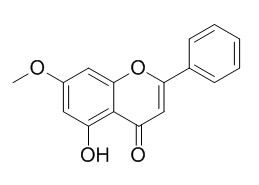Tectochrysin
Tectochrysin is a promising inhibitor for the reversal of ABCG2-mediated drug transport, it leads to apoptotic cell death in NSCLC cells through activation of DR3 and Fas expression via inhibition of STAT3 phosphorylation.Tectochrysin has antioxidant effect, it also exhibits a significant hepatoprotective activity in hepatic damage induced by CCl4-intoxication in rats.
Inquire / Order:
manager@chemfaces.com
Technical Inquiries:
service@chemfaces.com
Tel:
+86-27-84237783
Fax:
+86-27-84254680
Address:
1 Building, No. 83, CheCheng Rd., Wuhan Economic and Technological Development Zone, Wuhan, Hubei 430056, PRC
Providing storage is as stated on the product vial and the vial is kept tightly sealed, the product can be stored for up to
24 months(2-8C).
Wherever possible, you should prepare and use solutions on the same day. However, if you need to make up stock solutions in advance, we recommend that you store the solution as aliquots in tightly sealed vials at -20C. Generally, these will be useable for up to two weeks. Before use, and prior to opening the vial we recommend that you allow your product to equilibrate to room temperature for at least 1 hour.
Need more advice on solubility, usage and handling? Please email to: service@chemfaces.com
The packaging of the product may have turned upside down during transportation, resulting in the natural compounds adhering to the neck or cap of the vial. take the vial out of its packaging and gently shake to let the compounds fall to the bottom of the vial. for liquid products, centrifuge at 200-500 RPM to gather the liquid at the bottom of the vial. try to avoid loss or contamination during handling.
Vietnam J. Chemistry2022, 60(2):211-222
Evid Based Complement Alternat Med.2015, 2015:165457
HortTechnology2016, 26(6):816-819
Plant Cell,Tissue & Organ Culture2016, 127(1):115-121
Front Nutr.2024, 11:1409309.
BMB Rep.2020, 53(4):218-222.
AMB Express2020. 10(1):126.
Int Immunopharmacol.2024, 143(Pt 2):113486.
Food and Fermentation Industries2019, 45(7):45-51
Nutraceuticals2022, 2(3),150-161
Related and Featured Products
Arch Pharm Res. 2003 Jan;26(1):43-6.
In vivo anti-oxidant activities of tectochrysin.[Pubmed:
12568357]
The anti-oxidant activities of Tectochrysin, a major compound of propolis, were investigated.
METHODS AND RESULTS:
Tectochrysin exhibited a significant decrease in serum transaminase activities elevated by hepatic damage induced by CCl4-intoxication in rats. Tectochrysin tested exhibited a lipid peroxidation causing a significant decrease in MDA production in TBA-reactant assay. Tectochrysin was strong in the increase in the anti-oxidant enzymes such as hepatic cytosolic superoxide dismutase, catalase and glutathione peroxidase activities in CCl4-intoxicated rats.
CONCLUSIONS:
These results suggest that Tectochrysin possess not only the anti-oxidant, but also the activities in CCl4-intoxicated rats. Especially, Tectochrysin was found to cause significant increases in the rat liver cytosolic SOD, catalase, GSH-px activities as well as a significant decrease in the MDA production.
Cancer Lett. 2014 Oct 10;353(1):95-103.
Anti-cancer effect of tectochrysin in NSCLC cells through overexpression of death receptor and inactivation of STAT3.[Pubmed:
25083589]
Phenolic compounds (flavonoids and phenolic acid derivatives) are the most important pharmacologically active ingredients, and these compounds could inhibit proliferation of human cancer cells by inducing of apoptotic cell death.
METHODS AND RESULTS:
Here we focused on the anticancer effects of Tectochrysin on human non-small-cell lung cancer (NSCLC) cells and its mechanism of action. We analysed the activity of Tectochrysin on NSCLC cells (A549 and NCI-H460) by use of Western blot analysis for major apoptotic proteins and death receptor expression. We also used EMSA for effects on STAT3 DNA binding activity. Tectochrysin (0-80 μM) suppressed the growth of A549 and NCI-H460 lung cancer cells by inducing of apoptotic cell death in a concentration dependent manner. Expression of DR3 and Fas as well as DR downstream pro-apoptotic proteins including cleaved caspase-3, cleaved caspase-8, cleaved caspase-9 and Bax were concomitantly increased, but the expression of anti-apoptotic proteins; Bcl-2 was decreased in both cancer cells. In addition, Tectochrysin treatment also inhibited phosphorylation of STAT3 in A549 and NCI-H460 cells. However, deletion of DR3 and Fas by small interfering RNA significantly reversed Tectochrysin-induced cell growth inhibitory effect as well as down regulation of STAT3 in A549 and NCI-H460 lung cancer cells. Pull down assay and docking model showed interaction of Tectochrysin with STAT3.
CONCLUSIONS:
We propose that Tectochrysin leads to apoptotic cell death in NSCLC cells through activation of DR3 and Fas expression via inhibition of STAT3 phosphorylation.
Cancer Res. 2005 Jun 1;65(11):4852-60.
Flavonoid structure-activity studies identify 6-prenylchrysin and tectochrysin as potent and specific inhibitors of breast cancer resistance protein ABCG2.[Pubmed:
15930306]
Overexpression of breast cancer resistance protein ABCG2 confers multidrug resistance in cancer cells. The GF120918-sensitive drug efflux activity of human wild-type (R482) ABCG2-transfected cells was used for rational screening of inhibitory flavonoids and establishment of structure-activity relationships.
METHODS AND RESULTS:
Flavones were found more efficient than flavonols, isoflavones, and flavanones. Differentially substituted flavone derivatives indicated positive OH effects at position 5, in contrast to positions 3 and 7. A methoxy at position 7 was slightly positive in Tectochrysin, whereas a strong positive effect was produced by prenylation at position 6. The potency of 6-prenylchrysin was comparable with that of GF120918 (IC50 = 0.3 micromol/L). Both 6-prenylchrysin and Tectochrysin seemed specific for ABCG2 because no interaction was detected with either P-glycoprotein or MRP1. The ABCG2 resistance profile in vitro is altered by mutation at amino acid 482. The R482T mutation limited the effect of prenylation on ABCG2 inhibition. Whereas GF120918 strongly inhibited the ATPase activity of wild-type ABCG2, neither 6-prenylchrysin nor Tectochrysin altered the activity. In contrast, all three inhibitors stimulated the ATPase activity of mutant ABCG2. 6-Prenylchrysin at 0.5 micromol/L efficiently sensitized the growth of wild-type ABCG2-transfected cells to mitoxantrone, whereas higher concentrations were required for the mutant ones.
CONCLUSIONS:
In contrast, 1 micromol/L Tectochrysin was sufficient to fully sensitize mutant ABCG2-transfected cells, whereas higher concentrations were required for the wild-type ones. Both flavones exhibited a lower intrinsic cytotoxicity than GF120918 and were apparently not transported by ABCG2. 6-Prenylchrysin and Tectochrysin therefore constitute new and promising inhibitors for the reversal of ABCG2-mediated drug transport.



